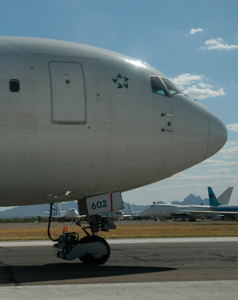One of the oldest names in electrical machinery, Ward Leonard, has signed an agreement to develop and build an advanced motor system to propel aircraft on the ground, thus avoiding the need to run their main jet engines or use external tug vehicles. As well as cutting the operating costs of a typical passenger aircraft by more than $500,000 a year, the technology will also reduce noise levels and emissions of carbon dioxide and other greenhouse gases.
The US-based Ward Leonard Electric Company has signed the agreement with a Gibraltar-based company called WheelTug, which has been developing the concept for several years, based on a high-torque multi-phase motor known as the Chorus motor. Ward Leonard will develop and build the motors, bearings, gearing and other components to fit inside the hub of each of an aircraft’s two nose wheels. The first aircraft likely to use the system is Boeing’s 737NG model and specifications are expected to be completed with a few months.

The two motors, just centimetres wide, will produce enough torque to drive a large aircraft at normal taxi speeds. The idea of using electric motors to drive aircraft on the ground is not new but, according to WheelTug president Isaiah Cox, “until recently there was no motor technology with the capability to produce the required high torque for its small size, weight and safety profile to make it possible”.
The concept was first demonstrated in 2005 when two Chorus motors were attached to the nose wheels of a Boeing 767 aircraft which was driven forwards and backwards in a series of tests. Since then, WheelTug has been resolving several key engineering challenges, such as the need to fit the whole system, including the wheels, into the existing nosewheel envelope. “This was widely seen as an enormous, and perhaps, insurmountable, problem,” Cox admits.
Other design criteria included:
♦ not increasing the wheel assembly spin-up loads during landing;
♦ avoiding changes to existing landing gear components, such as piston/axle assemblies;
♦ ensuring that the motors did not engage with the wheels unless the aircraft was in the ground and pilot had powered-up the system;
♦ matching the motor and wheel speeds before engagement, to eliminate the need for a clutch; and
♦ ensuring that the on-board APU (auxiliary power unit) had sufficient capacity to power the drive motors at the same time as other on-board electrical loads.
“Industry experts told us it would require years more work to solve these tough problems,” says Cox. “But with brilliant performance from our engineers and consultants, we have met every one of these requirements, and have now resolved these critical engineering and design issues in the WheelTug system”.
WheelTug is talking to aircraft manufacturers and airlines about developing the system for other types of aircraft, including military vehicles.
Cox describes Ward Leonard as “the perfect partner” for developing the motor technology. The company, which dates back to 1896, now designs and builds high-performance, high-reliability motors and control systems for demanding applications such as military, oil exploration and nuclear power. “They bring decades of relevant experience, along with state-of-the-art skills and tools for developing and delivering the most technologically advanced and rugged motors,” says Cox.
Another US company, the Kansas-based ICE Corporation, is developing the inverter controls for the WheelTug system.




